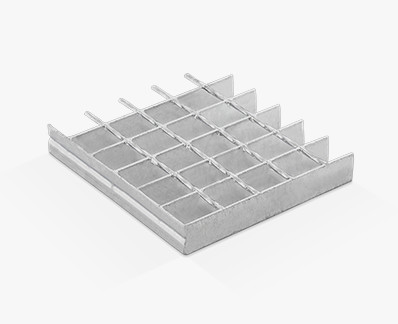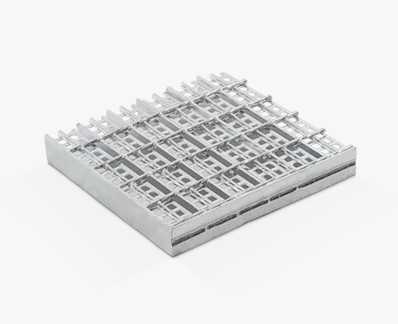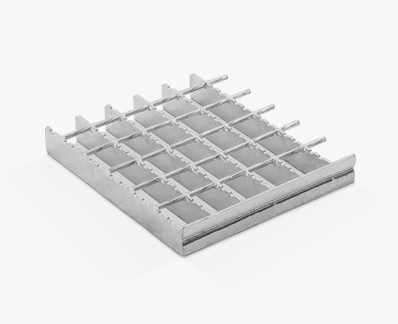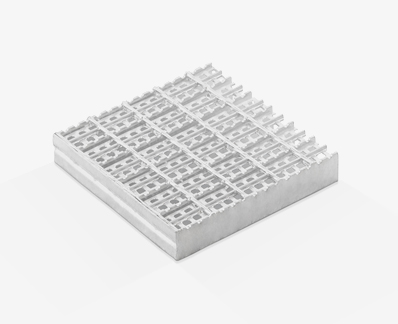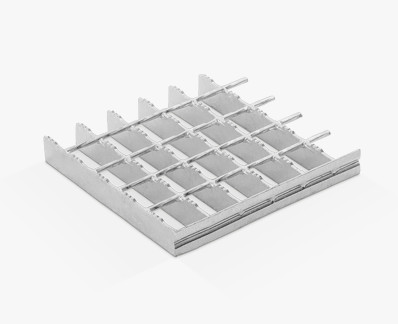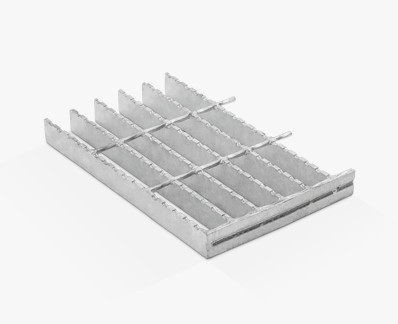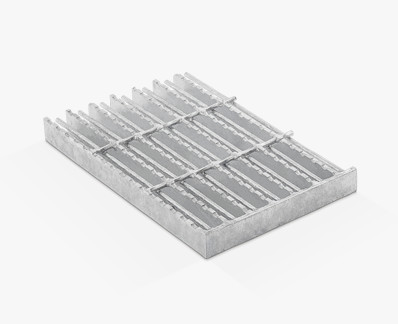Electrowelded grating or tramex
The
electrowelded grating is a type of metal grating where the union of the
bearing plates and the transverse elements,
delivered square or smooth rod, is made by the combined action of
fusion welding, without input of material, and concentrated pressure on the knots. The rigid union at each intersection is guaranteed, the monolithism of the grid and the absence of gaps that diminish the protection of the galvanized, and can be manufactured in carbon steel, galvanized or untreated, and in stainless steel. It can be applied to soil tramex. The
electrowelded grating or tramex is composed of bearing plates and a separator element, which can be either a delivered square or a smooth rod.
The manufacturing process of Grupo Relesa is carried out by
electrowelding, as its name indicates, and it stands out for the system used in the union of the supporting plates and the separator, consisting of fusion welding without material input, They perform joint solidarity in their knots that form a single monolithic body. The heat required for welding at the melting temperature is obtained by electric energy. This, together with the pressure exerted by an electrode, causes the penetration of the separator inside the load plates, resulting in
a compact and resistant product as a whole, in addition to being able to make cuts without danger that it can be disarmed. Except when untreated panels are supplied for further processing, the rest of our welded grilles are framed with plates at the ends of the supporting plates, being closed on all four sides.
Process also performed by electrowelding without material input, unless we are talking about cuts, in which the closing frame will be welded manually or where necessary.
Types of electrowelded grating
As described at the beginning, the welded grille is composed of bearing plates and separating elements, and the following elements can be modified to make the different types:
Supporting plate: In this element of the grid you can change both its height and its thickness. The higher the height and thickness, the greater the resistance of the same as a general rule.
Separator: This element will vary its thickness depending on the material to be manufactured and its use. Although this is not considered for loading purposes, it has an important function, since it serves as a binding and bracing of the bearing plates. Choosing an optimal dimension of the separator is key because increasing the section of the same when it is not necessary the only thing that will bring weight and a price increase. When we talk about
electrowelded grating for decoration (usually fenced) you can use a smooth round separator, since in this use it is not necessary to create the anti-slip effect that is achieved with the delivered square separator. Once these two elements are defined, the other change that can be made is the configuration of the mesh, that is, the distance between the supporting plates and the separators. In general, when the distance between the load plates is less, the greater the load on the grid, Not so with separators you reduce or increase the distance between them will be made to
meet different regulations or lighten the weight of the material to reduce its price.
Types of grids according to regulations or uses: Common materials
When you need to
comply with a specific regulation, you can
play with the opening of the mesh. Let’s take the example of France, whose safety regulations state that on grating platforms where people are going to transit below it, the same must prevent the passage of objects of diameter greater than 20mm (in Spain are 8mm) and that regulation does not specify whether that requirement is to be met by means of carrier or separators. Culturally, the French market has internalized the mesh 21mm separation between the bearing plates but this, However, its regulations can be met with a 34mm mesh between axles leaving the distance of the spacers at 23mm so that with a plate thickness 2 would result a free light of 19mm, material that prevents the passage of an object of 20mm and would comply with the regulations of the French country. Other common materials when for example the
use of the electrowelded grid is to support the passage of vehicles (whether they are cars, vans, trucks or forklifts) can be the thickness of 4 and 5mm. The use of both depends on the type of vehicle and the distance between the supports where the grid is placed. The shorter the distance, the lower the height and thickness of the grid and the greater the load on the vehicle.
Industrial use
It is probably one of the final destinations that represent the highest percentage in the use of the electrowelded grid in many of its variants, both on walkways and platforms and on stairs with grid rungs. The grid is undoubtedly an ally in the industry and as we have commented in other publications we can find it in industrial ships, oil platforms, factories of different products, mines, etc. It has also already been written about the
advantages of using the grid in such installations.
Fences
When it comes to enclosures or even railings, some customers opt for the
pressed grid for an aesthetic matter, however, with an electrowelded grid can also combine the meshes to achieve the desired result by the customer. Among the advantages of this type of grids, in addition to the resistance of the same even if not for pedestrian crossing, we can also highlight the lower accumulation of dirt compared to the pressing (although the cleaning of the grids is very simple) , besides getting good aesthetic finishes also counting on the option of putting the separator with smooth round instead of delivered.
Other uses
In addition to the above mentioned we can add:
shelving, ventilation grid, sinks in car washes or in kitchens, facades, false ceilings, tree guards, etc. The list of uses is very wide and we can find electrowelded grid in unsuspected places. Given its multidisciplinarity, the uses are almost unlimited due to the characteristics of this product and the different options for its manufacture.

